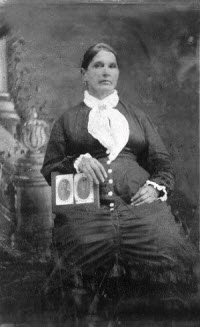Annotation:Quindaro Hornpipe
Back to Quindaro Hornpipe
QUINDARO HORNPIPE. AKA - "Quindaro," “Qumdaro.” American, Scottish; Hornpipe or (seldom) Reel. USA, New England. G Major. Standard tuning (fiddle). AABB (most versions): AA'BB (Kerr). New York City writer, researcher and musician Don Meade finds the tune was named for a Kansas town founded by abolitionists in 1856, and subsequently abandoned. New Hampshire fiddler Randy Miller expands on the origins of the name:

Quindaro Brown was the daughter of Adam Brown, a Chief of the Ohio Wyandot Tribe. In traditional Wyandot, “Quindaro” refers to the leadership role of a first born daughter; it is “also a word that some interpret by the adage ‘In union there is strength.’ At the time of the Wyandot’s forced removal to Kansas in the 1840s, Abelard Guthrie, a U.S. Land Office agent, fell in love with Quindaro Brown and married her. In Kansas, Quindaro was able to convince her tribespeople to sell land to a company for a townsite in present-day Kansas City. The town of Quindaro was the first Free-State port on the Missouri River, an underground railroad site and a temperance town. At the time of its founding in 1856, it was a beacon of hope for anti-slavery advocates in a sea of pro-slavery adherents. The Quindaro townsite was listed on the National Register of Historic Places in 2002. The tune seems to commemorate the town and its namesake. ... [Randy Miller, Monadnock Folklore Society webpage, 2008 [1].
Burchenal prints it as a tune for the dance "Boston Fancy." See also the similar “Douglas Hornpipe.”
Source for notated version: fiddler Pete Sutherland (Vt) [Phillips].
Printed sources: Burchenal (American Country Dances, vol. 1), 1918; pp. 39 40 (appears as "Boston Fancy" [2]). Cole (1000 Fiddle Tunes), 1940; p. 104. Ford (Traditional Music in America), 1940; p. 117. Kerr (Merry Melodies), vol. 2; No. 367, p. 40 (appears as "Qumdaro"). Kerr (Merry Melodies for the Piano), p. 28. Miller & Perron (New England Fiddler’s Repertoire), 1983; No. 120. Phillips (Traditional American Fiddle Tunes), vol. 2, 1995; p. 217. Ryan’s Mammoth Collection, 1883; p. 139. Songer (Portland Collection), 1997; p. 163. Spadaro (10 Cents a Dance), 1980; p. 41. Tolman (The Nelson Music Collection), 1969; p. 13. White’s Unique Collection, 1896; No. 135, p. 24.
Recorded sources: Biograph 6007, Ebenezer "Tell It To Me." Whistler’s Music 9859, Sarah Bauhan - “Chasing the New Moon” (1991).
See also listing at:
Jane Keefer's Folk Music Index: An Index to Recorded Sources [2]
Back to Quindaro Hornpipe
